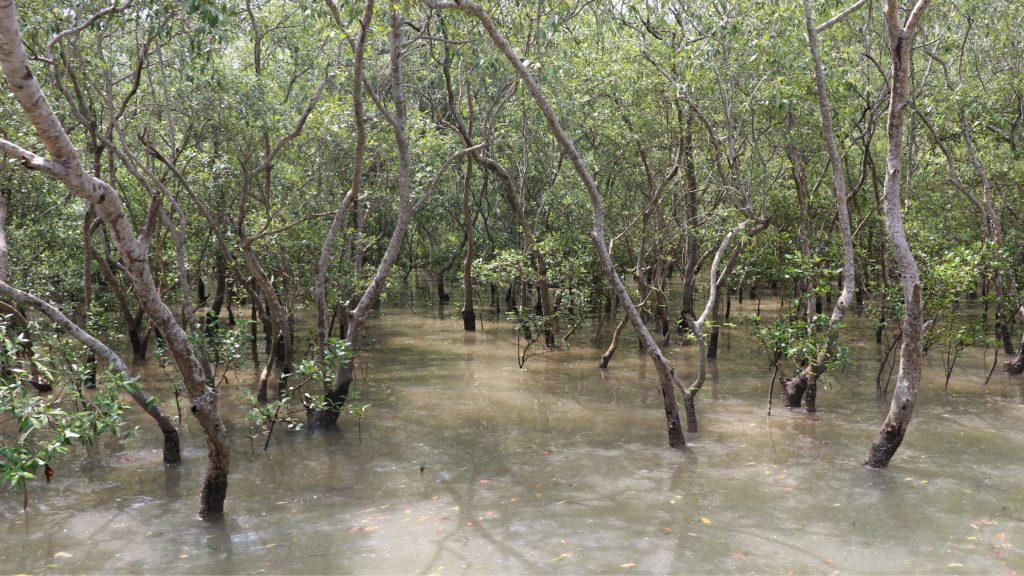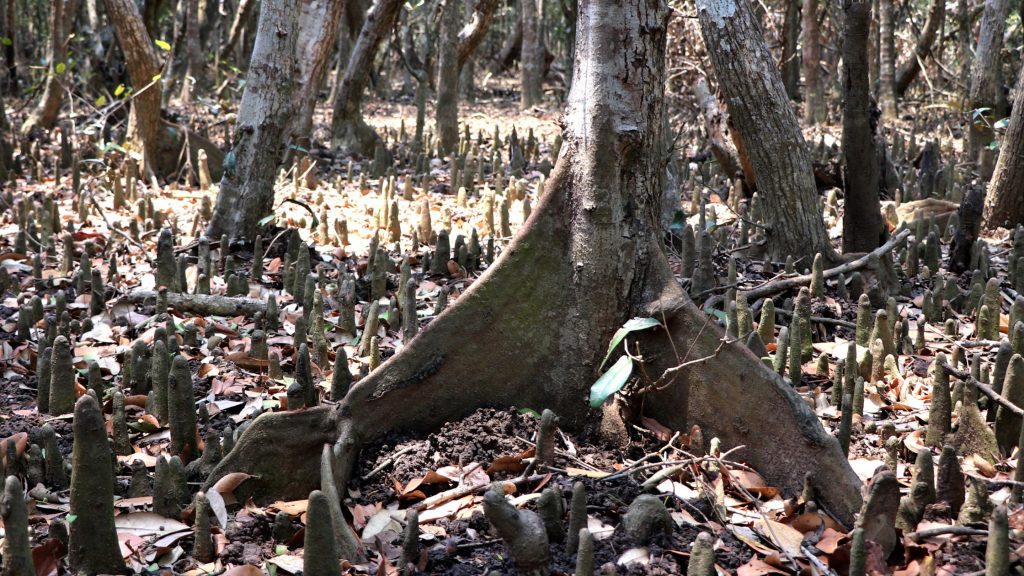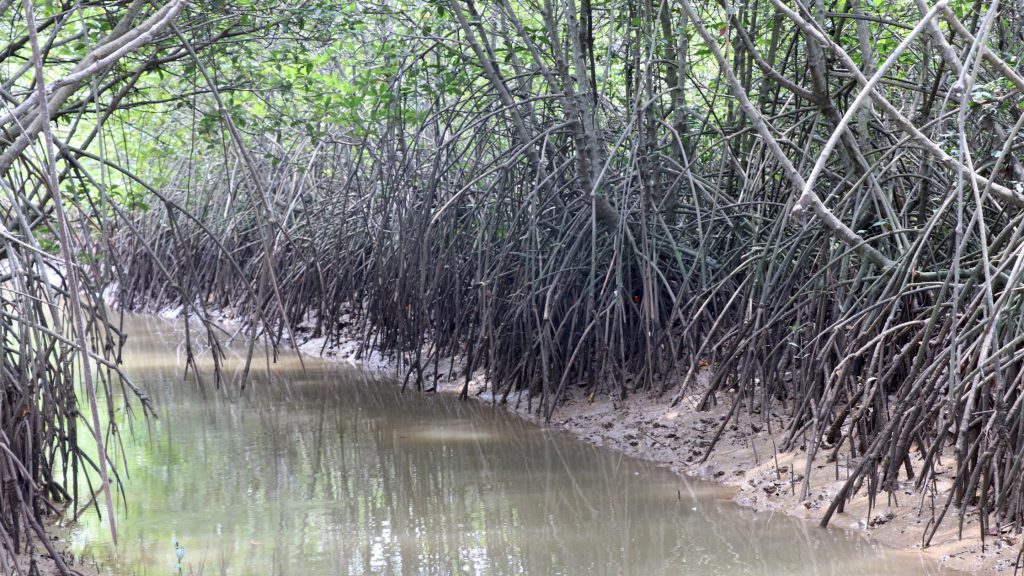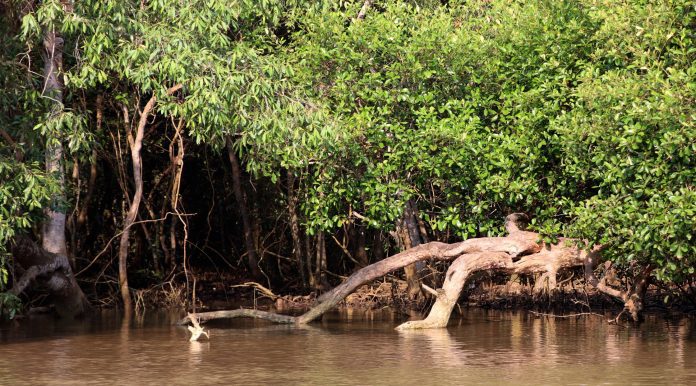Mangroves make one percent of the tropical forests of the world. Mangroves comprise of unique vegetation mixes found in coastal areas in the intertidal regions where freshwater and saltwater intermix such as bays, estuaries, creeks, and lagoons. They are halophytic in nature and can survive under coastal weather conditions. Mangroves have specialized anatomic and adaptation features like succulent leaves, pneumatophores, viviparous germination, salt vomiting leaves, breathing roots, extra stem to support the plant, stilt roots, buttresses, elastic aerial roots, underground cable root and they exhibit coppicing nature with new shoots after damage. Mangroves are remarkably adapted like no other group of plants in the entire plant kingdom with such adaptation.
Mangroves have proven to be excellent windbreaks against cyclones in the east coast of India, reducing the adverse impacts of the high-speed winds to protect human settlements, livestock, and infrastructure. Mangroves comprise of unique vegetation mixes found in coastal areas in the intertidal regions where freshwater and saltwater intermix such as bays, estuaries, creeks, and lagoons. They are economically and ecologically significant. They contain complex salt filtration system and complex root systems to cope with salt water immersion and wave action. At present, as global temperatures change and sea levels rise, if we do not focus on mangrove restoration and conservation, it is estimated that by 2050, more than half of the mangrove forest will disappear and the sea level will increase to around 6 mm/year.
Globally, mangroves have been decreasing from 2 to 8 percent annually. Over the last three decades, 40 percent of mangroves have been reduced to farmlands and housing colonies. India has already lost 35,000 hectares of mangroves due to shrimp farming, and several species are on the verge of extinction. The Hon’ble Supreme Court has banned semi-intensive and intensive aquaculture in coastal areas. The apex court had ordered the identification of suitable sites for mangrove plantations and the development of nurseries.

Mangroves, as we understand as wild tall trees in the coastal muddy intertidal areas. But its origin is not known exactly, but Northern Australia and Malaysia are considered its origin. most of them are Woody trees and shrubs, but some are non-Woody (Nypa palm) or are herbaceous (Acrostichum and Acanthus). Some of the important mangrove species include – Avicennia officinalis, Excoecaria agallocha, Rhizophora mucronate, Sonneratia alba, Avicennia marina, Bruguiera cylindrica, Heriteira littoralis, Phoenix paludosa, Ceriops tagal etc. are some of common mangrove species.
There are other plants called mangrove associates, such as Aegiceras corniculatus, Salvadora persica, Pongamia pinnata, Colubrina asiatica, Capparis roxburghii, Acanthus illicifolius, Bruguiera gymnorrhiza etc.
They are economically and ecologically significant. They contain complex salt filtration systems and complex root systems to cope with salt water immersion and wave action. Mangroves make 1 percent of the tropical forests of the world.
Mangroves in India
India has 4,975 km2 area of mangrove cover, Indian mangrove shows highest number of biodiversity and shows highest number (43) of species diversity. India has 3 percent of the total mangrove cover in South Asia. Mangrove Cover in India is 4975 sq km (0.15 percent of the total geographical area.). Mangrove cover is divided as – Very Dense – 1476 sq km (29.66 percent); Moderately Dense – 1479 sq km (29.73 percent); Open Mangroves – 2020 sq km (40.61 percent).
Sundarbans is the largest mangrove forest in the world and is named after a tree species called Heritiera foams (Sundari) which is now part of the globally threatened list. The east coast of India (Odisha) has an abundant number of Sundari trees. Bhitarakanika mangrove forest in Odisha is the only mangrove forest in the world that has been declared as a Ramsar site. The highest record of biodiversity in Indian mangroves is 5,746 species (43 mangroves+881 other floral species + 4,822 fauna), no other countries in the world recorded such diversity. The Mangrove-Faunal Genetic Paradise of the World is Sundarbans and the Mangrove Plant Genetic Paradise of The World is Bhitarakanika (Odisha). Interestingly, some of the most marginalized and poor communities live in the vicinity of the Mangrove forests and are dependent on the sea and forests for their livelihoods. Mangrove species like Sundari have a specific cultural significance to the local communities like provisioning of food and shelter, tree parts being used as fences, dyes for tapa cloth, fish traps, etc., However, most of them are engaged in fishing, hunting, poaching, and other illegal activities along the sea coast.
Importance of Mangroves

Mangrove species protect coastal areas from Tsunami and soil erosions; due to their complex root systems. Mangrove acts as a green wall for the coastal population. Around 120 million people living near mangroves and depend on fisheries and other forest-dependent livelihoods. Mangrove Wood is a valued source of timber and fuel. They regulate the climate by storing more carbon in the soil (3.5 times higher than that of tropical upland forest). The carbon sequestration rate is higher in mangroves than other similar ecosystems. Indian mangrove absorbs 93 million tonnes of CO2 daily: valued at 372 million USD. A healthy mangrove population is considered extremely important as it is claimed to act as a barrier to the devastations caused by natural calamities. Coastal protection – for coastal defense up to 5 times more cost effective than “grey infrastructure” such as breakwaters. Mangroves play an important role in Water filtration (2-5 hectares of mangroves may treat the affluents of 1 hectare of aquaculture). Mangrove forests are important tourist attractions in over 2000 locations across the world. The Mangrove ecosystems in the world is worth over USD 800 billion.
Mangroves provide valuable ecosystem services, including carbon sequestration, coastal protection and habitat provision for a plethora of organisms. Mangrove ecosystem is a natural nursery ground for fish, crab, crustacean, reptiles. It is known as a favourite habitat for a wide variety of animals and birds. Sediment deposition is a visible feature which arrests coastal erosion and seawater pollution. The amount of soil erosion in the coastal area is reduced due to the soil accumulation by mangrove plants. In addition, mangrove forests play a key role in reducing global warming.
Challenges / Threats to Mangroves
Human society is on the brink of destroying these rare forests forever to meet its own needs. Increased Fishing and farming activities destroy the forest. Mangrove forests are one of the most threatened tropical ecosystems due to their slow maturation and destruction of mature trees further leads to decreased natural propagation in areas where they exist. A survey indicates in countries like India, Vietnam, 50% of mangroves have already been cut and diminished. Starting from over-harvesting of the trees to use as firewood, construction wood, charcoal production and animal fodder to using mangrove forest as dumping yards for solid wastes and for discharging the effluents from various sources.
High salinity, poor count of beneficial microbes and low level of available nutrients are also major cause of mangrove degradation. Mangroves forests are being threatened at an increasing pace. The other threats include – Logging, agriculture (lands being converted to paddy fields), Aquaculture/Shrimp culture, Pollution – sediment, solid waste and oil, coastal development/urbanization, River dams negatively impact the supply of mud that raises mangrove soils and freshwater flow which has a direct impact on coastal, sediment accumulation and nutrient deposition. The space required for their survival is increasingly getting occupied by buildings and agricultural practices.
Mangroves conservation

A nature-based solution is needed to address the challenges that the mangrove ecosystem faces. Forests are protected under the Forest Protection Act and protection is being undertaken using the participatory method of conservation with the help of the local people such as awareness and plantation programmes.
There are two other strategies, namely Promontory and Regulatory method for conservation of mangroves in India. Canal bank plantation is an effective measure for mangrove restoration which helps in free tidal flushing. In this process, salt water and fresh water can also be exchanged, which can also help sediment and nutrient accumulation. In addition, we can also restore mangrove by multiple canopy plantation (herb, shrub, tree) and mixed/closed plantation.
The common practices adopted by various state forest departments in India include:
- Communities and officials going for direct seed sowing, raised bed plantations, and fishbone channel plantations to restore degraded mangroves.
- Establishment and promotion of Eco-Development Committees and Van Suraksha Samiti to implement conservation projects in mangrove areas.
- Implementing restoration, protection, regeneration, and maintenance techniques to conserve mangroves.
- Some of these mangrove species need to be raised by the Forest department and local communities and planted consciously.
- Watch and ward need to be ensured for the proper growth of the saplings. This can be done in collaboration with the local communities and Forest Department.
- School children and youth must be oriented on the importance of mangrove species, especially on their importance in socio-economic and cultural value, better adaptability to local agro-ecological conditions, resilience to weather variabilities and natural disasters like cyclones, floods, tidal fluctuations etc. They should be motivated to conserve and protect mangrove species.
Government, NGOs, community, private sector, and civil society efforts
Off late, the Government of West Bengal and the Government of Odisha and a few environmental NGOs like WWF, KKS, bilateral donors like Sida, and civil society organizations like Save the Children India and local grassroots NGOs like TSRDS, etc., have supported local communities in the conservation of mangroves in India, especially in the climate hotspot regions like the Sundarbans. The mangrove plantations have thrived well have benefitted the community from its various ecosystem services including marine coast protection, promoting biodiversity, soil and water conservation etc. These mangrove plantations have proved to be quite beneficial especially during the cyclone Phailin, Hud Hud, Aila, Amphan, and Yaas.
The local communities were engaged in raising Mangrove saplings in nurseries, duly supported by the various donors. They could also get gainful employment for working in the community nurseries through the development projects.
Mangrove parks have also been established with 65 mangrove species in Sundarbans to educate young generation about Mangroves and its importance in daily life. Reliance Industries Limited has planted Mangrove species in 825 hectares near Jamnagar Plant Refinery in Gujarat.
Possible interventions to save mangroves
- Communities and officials going for direct seed sowing, raised bed plantations, and fishbone channel plantations to restore degraded mangroves.
- Establishment and promotion of Eco-Development Committees and Van Suraksha Samiti to implement conservation projects in mangrove areas.
- Implementing restoration, protection, regeneration, and maintenance techniques to conserve mangroves.
- Watch and ward need to be ensured for the proper growth of the saplings. This can be done in collaboration with the local communities and Forest Department.
- Ensuring collection of seeds and ex situ generation of saplings to return to sites where only a few plants exist to ensure better survival of the seeds would be a proactive step.
- Complete prohibition of any human activity and entry except for restoration activities in areas with low vegetation index is the urgent need to arrest the decreasing mangrove cover.
Also read: Effects of Global Warming and Climate Change
About the Author:
Mr. Ravi Shankar Behera is an independent freelance consultant and author based in Hyderabad. He is an Honorary Advisor to grassroots Voluntary Organizations on Food Security, Environment, and Social Development issues. Ravi has worked with international donors and NGOs over the last two decades and has a keen interest in Agriculture, Food and Nutrition, Environment, Natural Resource Management, and Climate Change issues.
Dr. Ranjit K. Sahu is an American laboratory and research specialist located in Virginia, USA. Dr. Ranjit is a freelance writer, artist, poet, and story writer. He has over 18 years of experience in Biotechnology and biomedical research. His interests include education, environment, sustainability, and health care systems and practices in the underprivileged regions of the world.
Mr. Chandan Kumar Sahoo is a Ph.D. research scholar at the Department of Biotechnology, Bharathiar University, Coimbatore, Tamil Nadu. Chandan has a keen interest in forest ecology (terrestrial and mangrove forest), microbiology, biomass, carbon sequestration, climate change, remote sensing and GIS.



Good write up. Hope the Government saves to protect the mangroves.